Burgh of Govan
In 1864 there were four shipbuilding yards in Govan, the population had grown to 9260 and tenements were being built to house workers, there were no street lighting, poor sewage system, and apart from police constables appointed by the County, there was no legally constituted body within Govan to adequately protect and represent the inhabitants.

After an earlier failed attempt to constitute a Police Burgh in 1855, ratepayers again met with the Sheriff of Lanarkshire in March 1864, at the public meeting pro-burgh campaigners held placards with the words; Dirt, Darkness, Disturbance and Disease, this time they agreed to form a police burgh under the terms of the General Police (Scotland) Act 1862.
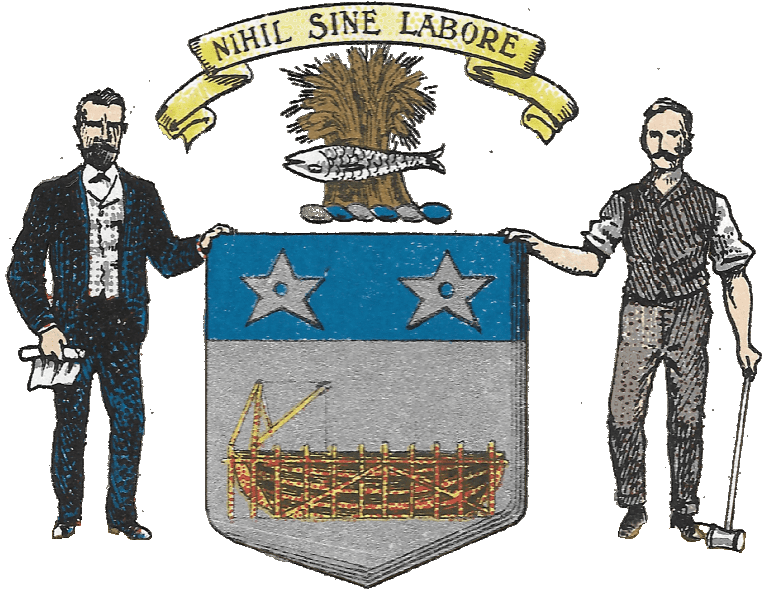
The Coat of Arms of Govan Burgh was approved in December 1864.
"Dirt, Darkness, Disturbance and Disease"
Under the Act ratepayers could elect their new municipal government, which consisted of a Chief Magistrate, two Junior Magistrates and nine ordinary Commissioners, they would be responsible for crime and punishment, water supplies, paving, lighting and maintenance of streets, sewers, drainage and cleansing, nuisance control and general public health. Despite not being officially entitled to do so until 1903, the police commissioners often used the titles of elected officials of established burghs, the Provost (Chief Magistrate), Bailies (Jnr. Magistrates) and Councillors (Commissioners).
The first meeting took place in June 1864 and the elected commissioners set about tackling the Dirt, Darkness, Disturbance and Disease.
In December 1864 the Commissioners approved the design for the Burgh common seal and agreed the seal’s motto of “Nihil sine labore” (“Nothing without work”), the arms on the seal was designed by lithographer John Brown, reflecting Govan’s new industries and agricultural past, it also is partly based on the coat-of-arms of the Rowan’s of Holmfauldhead. The arms were registered with the Lord Lyon Office in 1884.
The Burgh Arms and motto live on in the logo and motto for Govan High school; also their school tie and the socks of Rangers F.C. players bear the burgh colours of red and black.
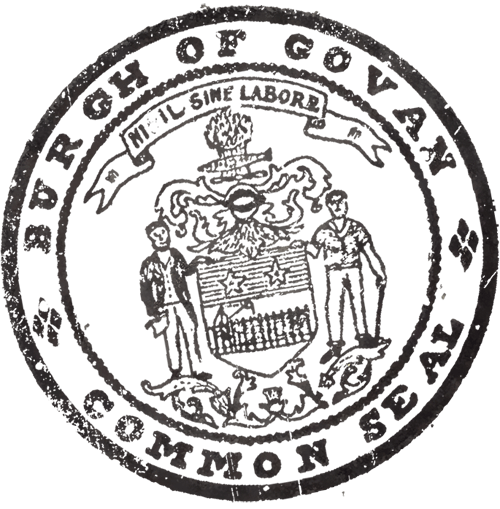
Burgh common seal was designed by local lithographer John Brown.
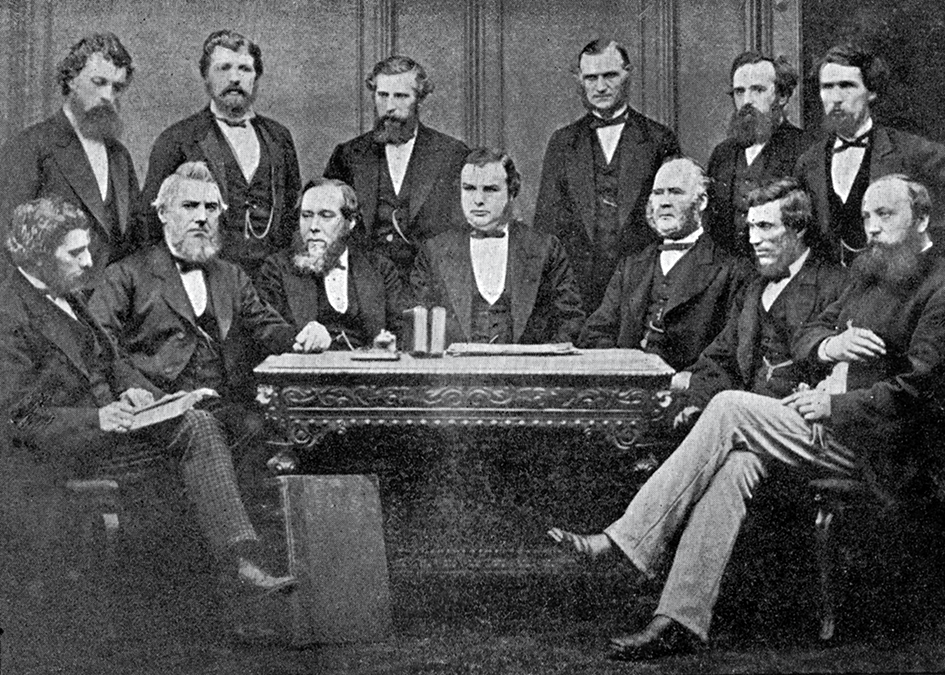
Provost Thomas Reid and Govan Burgh Commissioners in 1871.
Alexander Thomson (Fairfield Farm), George Wishart (Grocer), Peter Hutcheson (Gardener), Thomas Reid (Dye Work) and John Hinshelwood (Builder), are five of the first Commissioners of the Burgh elected in 1864, the other four Commissioners elected at that first meeting were; James McKean (Grocer), John Dobie (Shipbuilder), John Morrison and William Weir, three magistrates were also elected, Morris Pollok as Chief Magistrate and two Junior Magistrates; William Cruickshank and Andrew Fowler.
Photo to the leftPhoto below shows some early Govan Commissioners; Top row - left to right- Archibald McLean, Alex Thomson, Alex Campbell, George Wishart, John McFarlane and John McKechnie. Bottom row - left to right - W. Wilson (Town Clerk), John Hinshelwood, James Wilson, Thomas Reid (3rd Provost), Alex McKim, Peter Hutcheson and George Ledingham.
For the first few years the Govan Burgh Commissioners held their meetings at John Hinshelwood’s hall in Greenhaugh Street, however in 1865 they acquired a piece of ground in Albert Street (Orkney Street) in order to build the Burgh chambers. In 1866 a memorial stone with time capsule was laid and the building was completed in 1867.
Designed by John Burnet Snr., the frontage is of a Greco-Italian style, the ground floor contained the charge room as wells as offices for Commissioners and Clerks, the upper floor contained a large hall which was used as the courtroom and could accommodate up to 600 people, there was also a waiting room, magistrates room, chief-constable’s office and space for police officers.
In 1882 the upper floor was destroyed by fire and the building was restored, despite this, the Burgh Commissioners agreed in 1883 to build a new public hall and offices. It took another 15 years before the foundation stone was laid for this new and much grander hall which officially opened on Govan Road at Summertown Road in 1901.
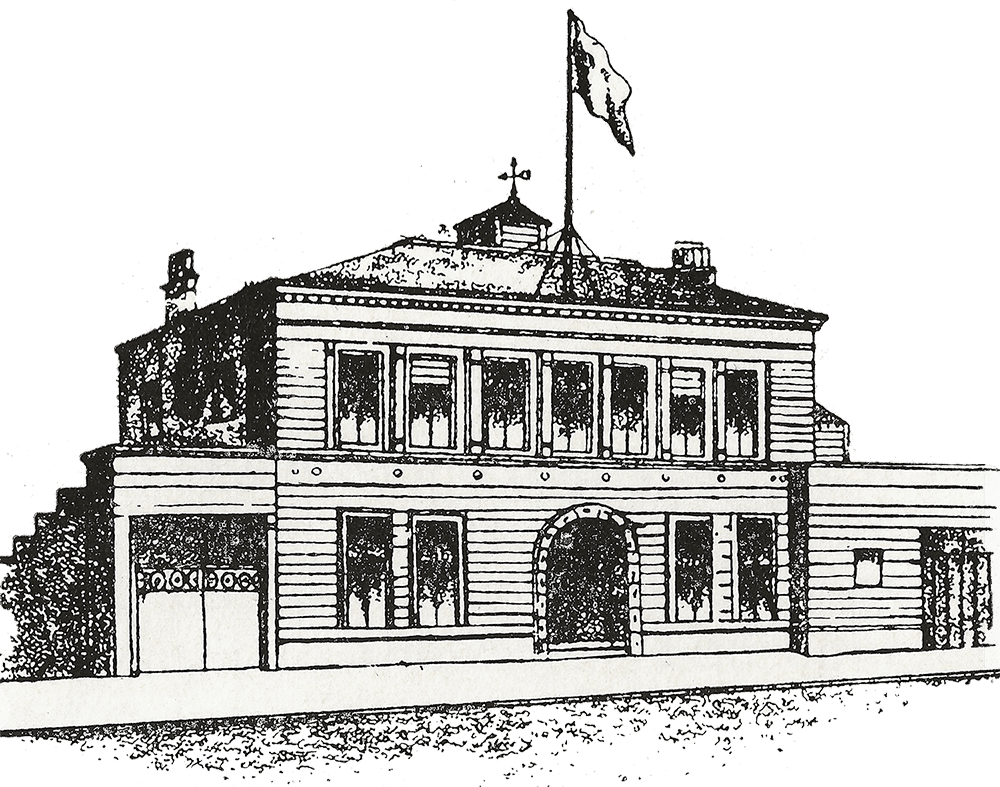
Govan Burgh Chambers, Albert Street (now Orkney Street).
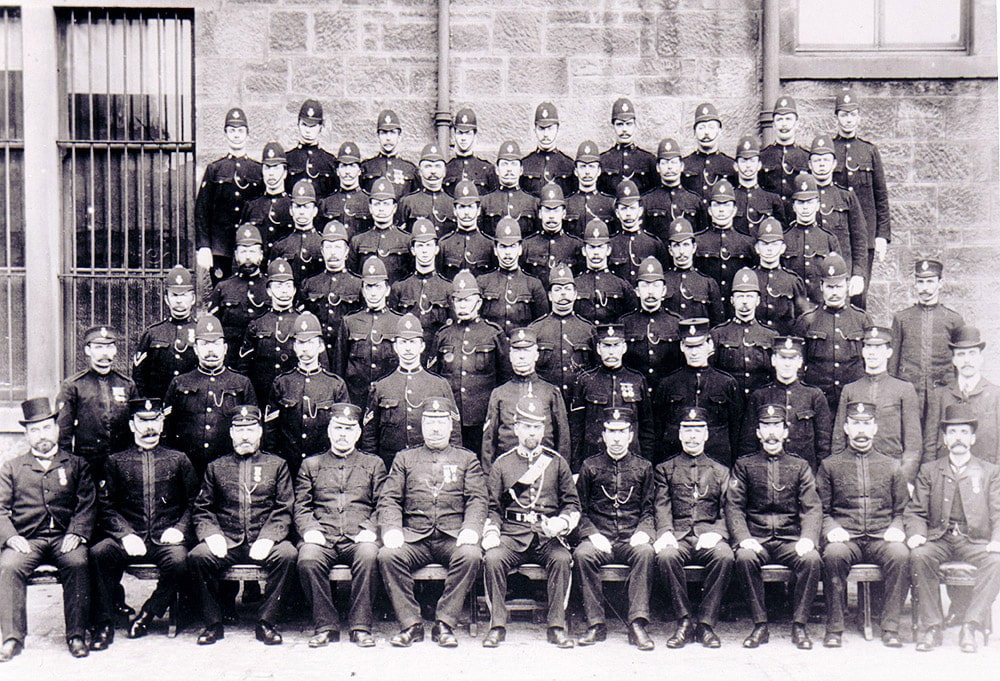
Govan Burgh Police, (Glasgow Museums).
One of the most visible aspects of Govan Burgh was the Police force, on 4th July 1864, David Young was appointed Superintendent of Police, Procurator Fiscal and Inspector of Nuisances, for which he was paid a total salary of £115, under his command was an Inspector named James McDonald who was paid 24s per week, there were also a total of 10 constables in three classes who were paid between 18s and 20s per week, these first 10 constables were; Alexander Dalglish, Alexander Fraser, Arthur Gemmel, Gregor McLeod, John Campbell, John Currie, Alexander Grant, Bartholomew McDonagh, Joshua Taggart and John Ferguson.
The police force shared the municipal building on Albert Street (Orkney Street) with the Commissioners. Quarters for constables were also built adjoining the station at 11 Broomloan Road.
Later a small fire service was based at the station until 1898 when a fire station was built next to the police station at Russell Street (Orkney Place), the part-time fire master and assistant fire master lived above the station, two tenements closes were also built in Russell Street (Orkney Place), these were initially used to house constables and their families (In 1901 all the PCs living in Russell Street were migrants from north east Scotland), however by 1912 there was an even split between fire men and constables living in the homes. Soon after the Commissioners vacated the burgh buildings for the new town hall, a new wing and cell block with 36 cells were built onto the station, the police force and magistrate court were now sole proprietors.
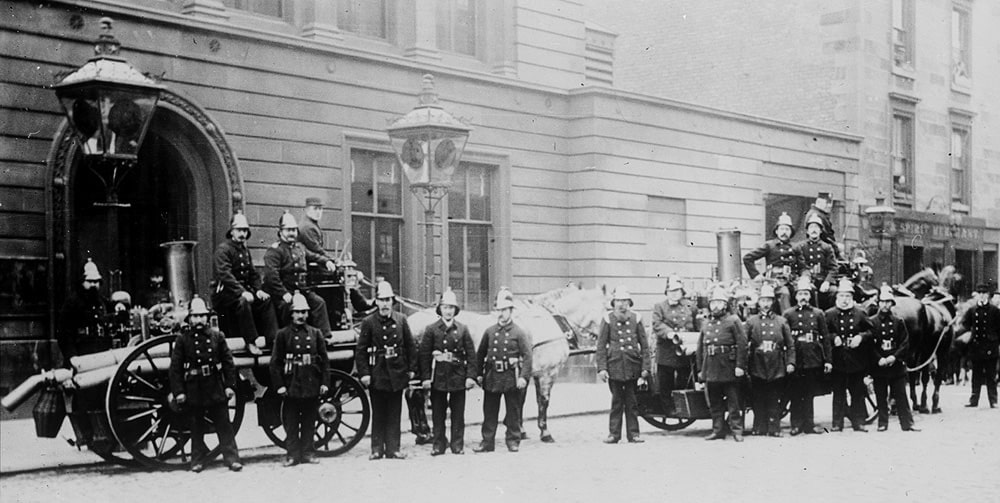
Govan Fire Brigade in Albert Street. (Glasgow Museums).
It wasn’t all police work at the station, a recreation ground was provided on Broomloan Road at Summertown Road and the Govan Burgh Police Pipe Band was established in 1883, in 1912 the band became the City of Glasgow Police Pipe Band and in 1975 the Strathclyde Police Pipe Band, in 2013 the name was changed again to the Greater Glasgow Scotland Police Pipe Band, in 2021 the band joined with other Scottish police pipe bands to form the Police Scotland and Federation Pipe Band. Piping still lives on in Govan today thanks to the Govan Schools and Community Pipe Band.
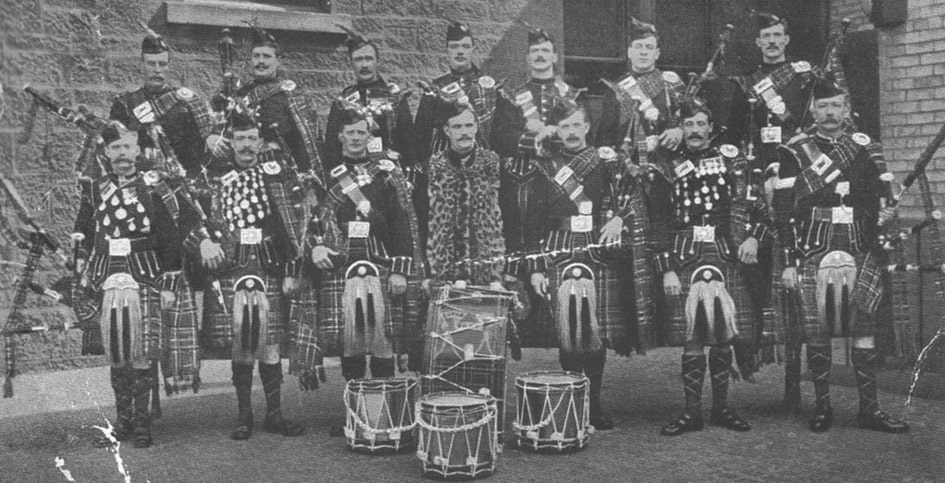
Govan Burgh Police Pipe Band was formed in 1883.
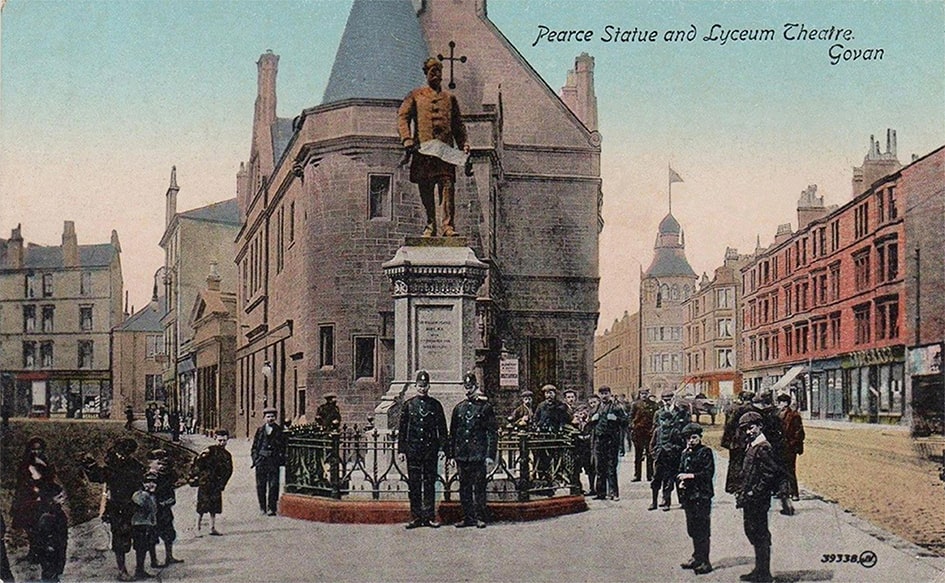
Postcard of Pearce Statue and Lyceum Theatre. (circa 1900)
As the population of the burgh grew, so did the police force, a police sub-station was added at Plantation in 1874-75 and another with mortuary was added at Fairfield in 1883-84, by 1905 there was also a fire sub-station at Plantation and the police force had grown greatly in number to; chief constable, four lieutenants, eight inspectors, eleven sergeants and ninety five constables. The Govan police force and fire service were absorbed into their Glasgow counterparts in 1912 , the Govan fire service moved to a new station on Govan Road in 1987 and Govan police moved to a new station on Helen Street in 1998, the former Burgh Chambers/Police Station is now the Orkney Street Enterprise Centre.
Victorian Govan could be a dangerous place to work, a fully equipped ambulance wagon was provided by the burgh in case of serious accidents in the shipyards or engineering workshops. The stables for the ambulance, police and fire wagons were situated between the police office in Albert Street and fire station in Russell Street, coachmen such as William Denson and John Muir lived in Russell Street along with the police constables and fire men.
Thanks to shipbuilders such as Napier, Elder and Pearce Govan was known as the “most shipbuildingest burgh in the world”, indeed the success of the Burgh owed a lot to the shipyards and its supporting industries, however for the worker who built the ships, work was irregular and low paid, and times could be very hard.
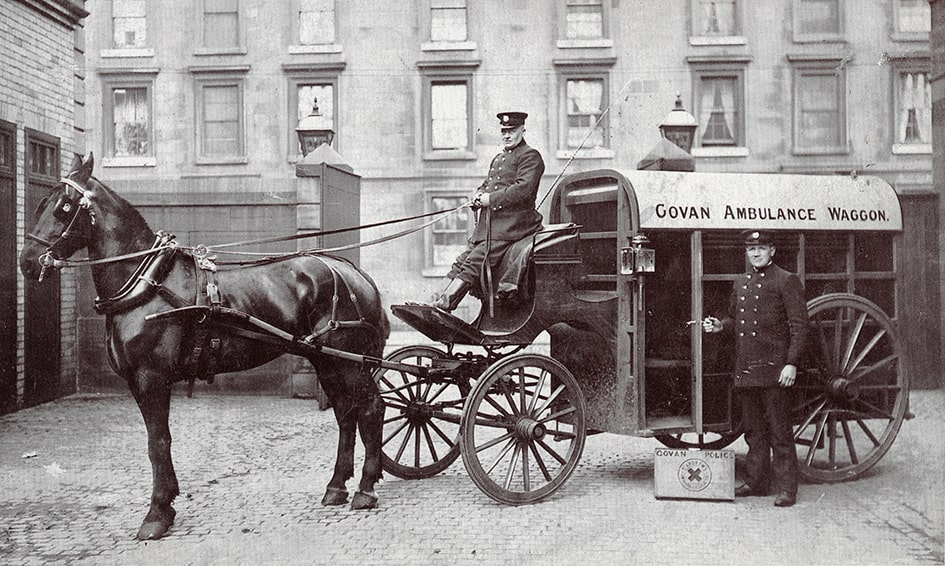
Govan Ambulance Waggon at stables in Albert Street.
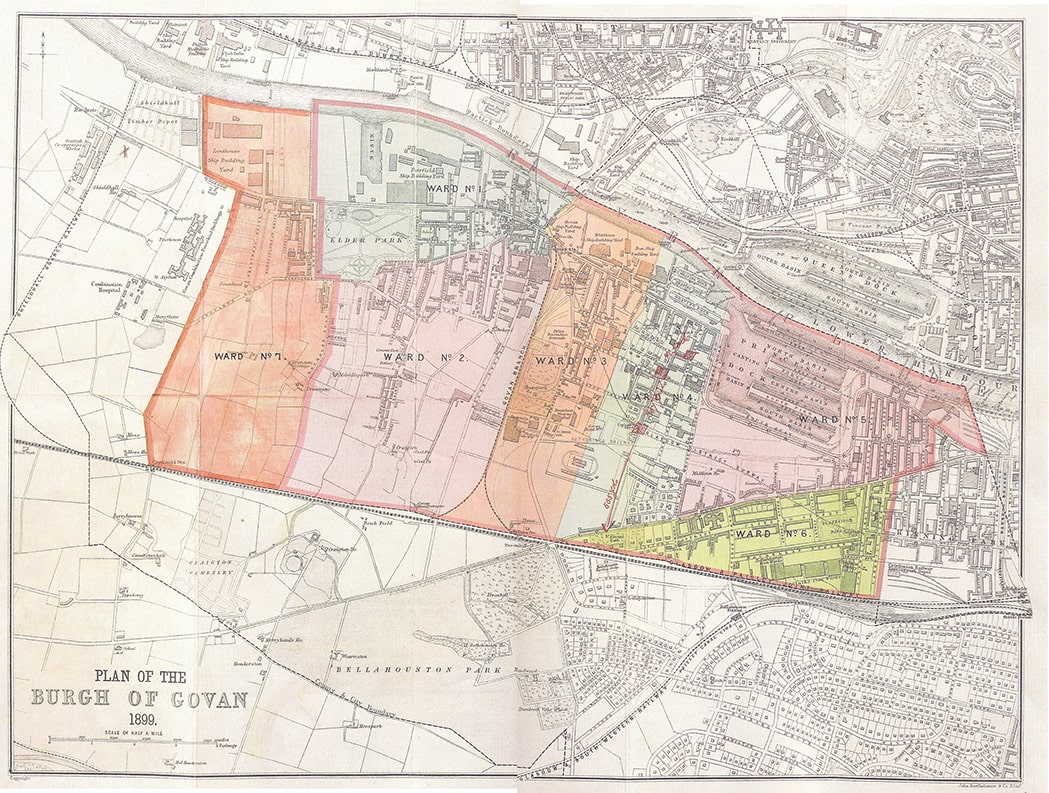
Map showing boundaries of Govan Burgh. (Glasgow City Archives)
By 1901, Govan was one of the largest towns in Scotland, it was a thriving and bustling town with many amenities, shops and factories. The tenements that dominated the Burgh were built over a 50 year period from the early 1850s to 1903, however they were overcrowded and the oldest were already severely dilapidated.
The Burgh stretched for two miles between Paisley Road Toll in the east, and Drumoyne Road and Drive Road in the west, measuring one mile at its widest point, it was bounded on the north by the river and in the south by Glasgow & Paisley Joint Railway. In 1871 the Burgh was divided into four wards with each ward being entitled to elect three Commissioners. In 1893 the Burgh was re-divided into six wards (Wards 1-6 on map), and the burgh now had; a Provost, eight Magistrates and eleven Commissioners. In 1901 the total Commissioners equalled 21 when South Govan (Linthouse and Drumoyne) joined the burgh as Ward No. 7, the amalgamation increased the population by 5,600 to 84,970.
Designed by Thomson and Sandilands the new grander halls were officially opened at Summertown Road and Govan Road in 1901, they were not just buildings to conduct the Burgh’s affairs, they were also about reasserting Govan’s independence from Glasgow, built facing out to its bigger neighbour, the new town hall was also a grand gesture of defiance.
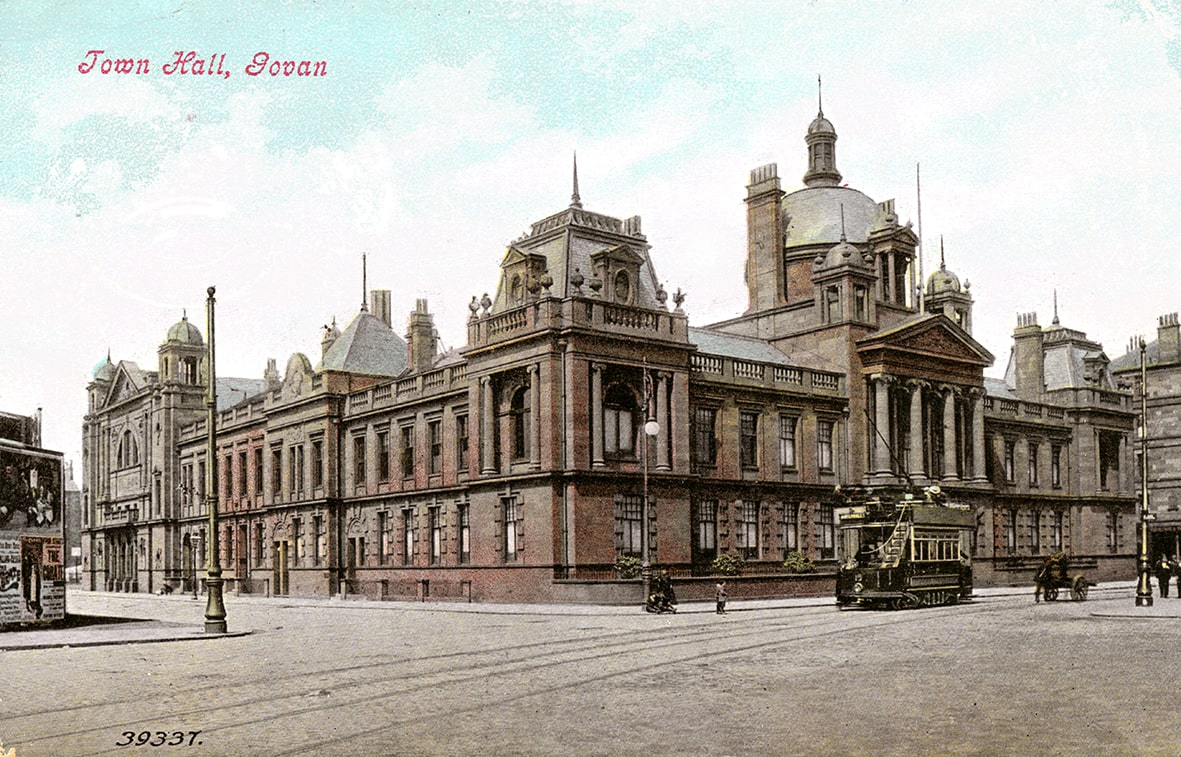
Govan Town Hall was designed by Thomson and Sandilands.
Govan Burgh had not long formed when in 1868 Glasgow showed its intentions to annexe Govan within its boundaries, after decades of many bitter annexation battles a Parliamentary committee fatefully sanctioned the annexation of Govan, Partick and Pollockshaws to Glasgow in May 1912 and on the 5th November 1912, Govan Burgh with a population of nearly 100,000 ceased to exist as it joined Glasgow, and by the look of some of the faces in the picture below, not all were happy about it.

Govan Town Hall was designed by Thomson and Sandilands.
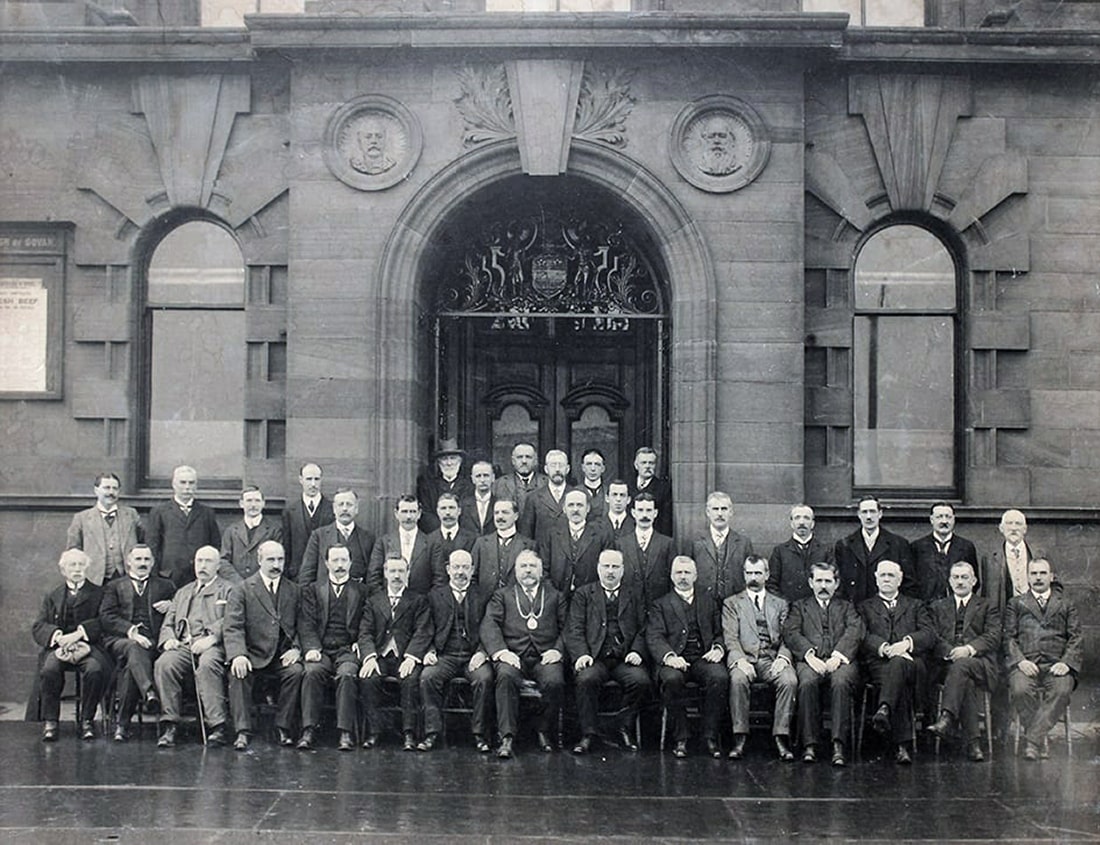
Last Govan Town Council outside Govan Town Hall in October 1912.
Govan Burgh Provosts
- 1864-1867 Morris Pollok Jnr.
- 1867-1869 William Cruickshank
- 1869-1872 Thomas Reid
- 1872-1880 James Wilson
- 1880-1883 John Thompson
- 1883-1886 Alexander Campbell
- 1886-1889 George Ferguson
- 1889-1892 Neil McLean
- 1892-1901 James Kirkwood
- 1901-1904 John Marr
- 1904-1908 John Anthony
- 1908-1912 David McKechnie
Services and Amenities Provided by the Burgh
- Police force and Magistrates courts.
- Fire and Ambulance service.
- Distribution of water and gas.
- Sewerage and drainage.
- Lighting streets by gas or electric (1900).
- Paving and cleaning streets.
- Building control.
- Public health and preventing infectious diseases.
- Weights and Measures.
- Plantation Public Park (1899).
- Alcohol licensing (from 1903).
- Summertown Road Public Baths (1901).